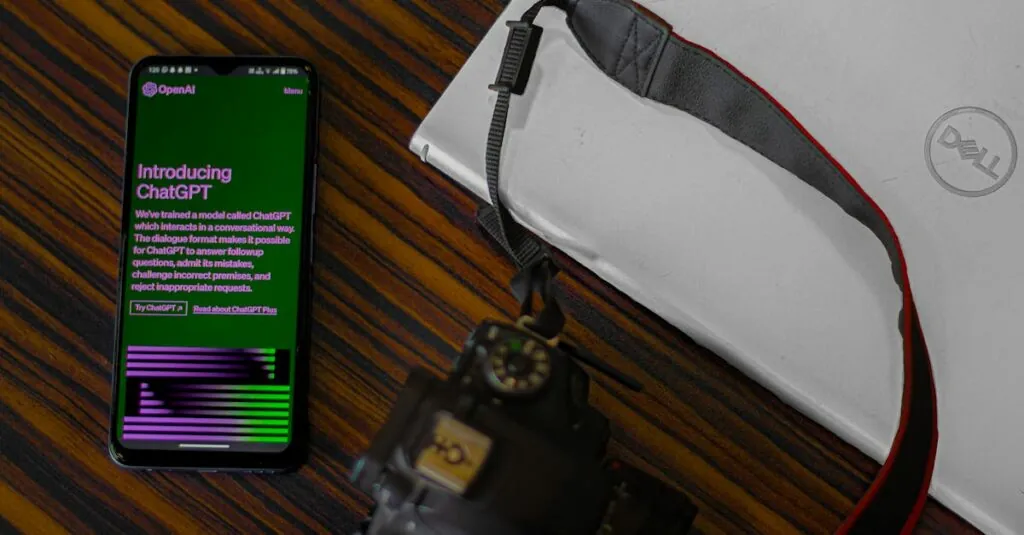In the epic showdown of smartphone cameras, the battle between iPhone and Samsung is nothing short of legendary. Picture this: you’re at a stunning sunset, ready to capture that perfect shot. Do you reach for the sleek iPhone or the powerhouse Samsung? Both brands promise jaw-dropping images, but which one really delivers when it counts?
With tech enthusiasts and casual snap-happy users alike weighing in, the debate rages on. Is it Apple’s iconic simplicity that wins hearts, or does Samsung’s innovative flair steal the spotlight? Join the frenzy as we dive into the pixel-packed world of smartphone photography, exploring features, performance, and that all-important “wow” factor. By the end, you’ll know which device deserves to reign supreme in your pocket.
Table of Contents
ToggleOverview of iPhone and Samsung Camera Systems
iPhone cameras excel in their user-friendly interface and consistency. Users appreciate the seamless integration with the iOS ecosystem, making photo sharing and editing simple. The latest iPhone models, like the iPhone 14 Pro, feature a triple-camera system, including ultra-wide and telephoto lenses, which enhance versatility.
Samsung camera systems, on the other hand, boast high megapixel counts and advanced zoom capabilities. The Galaxy S23 Ultra, for instance, offers a 200MP main sensor. This significant detail allows for detailed images and impressive cropping without loss of quality.
Dynamic range represents a crucial factor in camera performance. iPhones typically produce well-balanced exposures, even in challenging lighting like sunsets. Samsung’s approach often delivers vibrant colors but can struggle with overexposure in bright conditions.
Low-light photography showcases distinct advantages in both brands. While iPhone utilizes Night mode for clear images in darkness, Samsung employs advanced sensor technology that captures more light. Both devices produce impressive results, but individual preferences may influence choice.
Video recording stands as another comparison point. iPhone’s video quality remains exceptional with smooth stabilization and accurate colors. Samsung produces high-resolution video, but users may notice differences in color grading techniques between the two brands.
Feature-rich software complements both camera systems. iPhone emphasizes simplicity with its built-in editing tools, while Samsung offers a range of pro-mode features that allow manual adjustments. Preferences in usability impact user experience significantly.
Both iPhone and Samsung camera systems excel in different aspects. Various features and technologies contribute to their photography capabilities. Understanding the strengths of each can help users make informed decisions based on their photography needs.
Camera Specifications Comparison
This section compares the camera specifications of iPhone and Samsung smartphones, focusing on each brand’s unique features and capabilities.
iPhone Camera Features
The iPhone 14 Pro includes a triple-camera system that enhances versatility. It features a 48 MP main sensor, an ultra-wide camera, and a telephoto lens that supports 3x optical zoom. Night mode significantly improves low-light performance by capturing brighter images with enhanced details. Photographic styles offer users customizable settings, allowing for expressive photos tailored to individual preferences. Apple’s Deep Fusion technology enhances texture and detail across various lighting conditions. Optical image stabilization ensures clarity during handheld photography. Video recording capabilities include 4K resolution at up to 60fps, renowned for its cinematic quality and stability.
Samsung Camera Features
The Galaxy S23 Ultra stands out with its impressive 200 MP main camera. A periscope telephoto lens provides 10x optical zoom, enabling remarkable detail over long distances. Low-light photography benefits from advanced sensor technology and Super Night Mode, which improves image quality in dark environments. Samsung’s Space Zoom can reach up to 100x digital zoom, delivering versatility in distant shots. Scene Optimizer automatically adjusts settings based on the subject, ensuring optimal results. Video recording also features high-resolution capabilities, allowing for up to 8K video at 24fps, with color grading options for professional-level output. The camera app includes a Pro Mode for detailed manual control over various settings.
Image Quality Analysis
Both iPhone and Samsung cameras exhibit impressive capabilities, particularly in low-light situations and color accuracy, distinguishing their photography experiences.
Low-Light Performance
In low-light scenarios, the iPhone’s Night mode excels, capturing sharp images with minimal noise. Users appreciate its ability to balance brightness and shadow detail effectively. Samsung’s advanced sensor technology also performs admirably, optimizing settings for darker environments. Enhanced by Super Night Mode, Samsung devices produce vibrant and detailed images, though users may notice occasional noise at higher ISOs. Both brands strive to optimize low-light photography, ensuring users enjoy quality results regardless of lighting conditions.
Color Accuracy and Reproduction
Color accuracy shines in iPhone images, where tones look natural and true to life. This consistency appeals to many photographers who prioritize surface details. On the other hand, Samsung cameras often deliver vibrant colors, enhancing the visual impact of photographs. This vibrancy can result in slight oversaturation, which may not appeal to all users. Photographers looking for distinct color reproduction will find value in both options, as each device suits different creative preferences and styles.
User Experience and Features
User experience and features play vital roles in the camera performance of both iPhone and Samsung smartphones. Each brand offers unique attributes that cater to different photography styles and user preferences.
Camera App Interface
Samsung’s camera app showcases a user-friendly design with easy navigation, allowing quick access to various shooting modes. The layout presents icons and settings intuitively, enabling seamless transitions between options. In contrast, the iPhone camera app emphasizes simplicity, offering essential features at the user’s fingertips. The streamlined interface highlights crucial functionalities like Night mode and Photographic Styles prominently. Users often find that both apps facilitate efficient shooting experiences, though Samsung may provide more extensive customization options for advanced users.
Special Modes and Features
iPhone cameras come equipped with innovative features like Night mode and Cinematic mode, enhancing low-light photography significantly. Night mode captures detailed images even in challenging lighting, while Cinematic mode allows users to achieve professional-level depth-of-field effects. Samsung excels with its Super Night mode, ensuring vibrant images in low light as well. The Space Zoom feature provides standout capabilities for distant subjects. Both brands include Pro modes, but Samsung often offers more granular control over settings, appealing to photography enthusiasts. Feature sets from both brands cater to consumers who seek versatility and creativity in their photography experiences.
Real-World Photography Examples
Photography showcases the strengths of iPhone and Samsung cameras through various real-world scenarios. Examining their capabilities in portrait and landscape settings reveals exciting differences.
Portrait Shots
iPhone cameras excel in capturing natural-looking skin tones, making portraits vibrant and true to life. The iPhone 14 Pro’s Photonic Engine enhances details and textures, contributing to stunning results in well-lit environments. Samsung also impresses with its 200 MP sensor, providing remarkable clarity. The Galaxy S23 Ultra’s portrait mode adds a pleasing bokeh effect, creating depth and separation from backgrounds. Users appreciate both devices for their ability to define facial features, although iPhone’s color accuracy often edges out Samsung’s more saturated tones. Individuals looking for professional-quality portraits can benefit from either choice, depending on their preferred aesthetic.
Landscape Photography
Landscape photography showcases the strengths of both brands in dynamic environments. iPhone’s ultra-wide lens captures expansive scenes with impressive detail, emphasizing the beauty of natural vistas. Colors appear balanced and true to life, enhancing the overall composition. In contrast, Samsung’s Galaxy S23 Ultra shines with its high-definition resolution and vibrant saturation, highlighting landscapes in dramatic ways. The Super Night Mode lets users photograph low-light settings effectively, revealing beautiful starry skies or cityscapes. Each device provides unique features that enhance landscape shots, allowing photographers to select based on their preferred style and lighting conditions.
Choosing between an iPhone and a Samsung smartphone camera ultimately depends on individual preferences and photography styles. Each brand brings unique strengths to the table. iPhone users often appreciate the consistency and ease of use, especially in low-light situations. On the other hand, Samsung enthusiasts may lean towards the high megapixel capabilities and advanced features that cater to more technical photography needs.
Both devices provide impressive performance across various scenarios. Whether capturing vibrant landscapes or stunning portraits, users can find satisfaction in either option. The decision boils down to what features matter most in their photography journey, ensuring a rewarding experience regardless of the choice.








